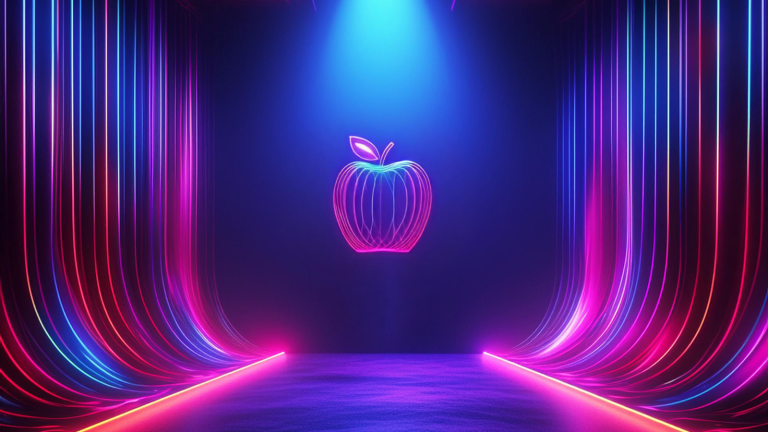Let’s be honest; Most people walked away from Apple’s Worldwide Developers Conference (WWDC 2025) earlier this week… unimpressed.
There was no shiny new VR headset or jaw-dropping “AI moment” like last year’s Apple Intelligence reveal.
Instead, the company’s big splash was something called Liquid Glass – a new design aesthetic that adds a glass-like shine effect throughout iOS. The crowd nodded, clapped politely, and moved on.
Social media users called it “pretty but iterative,” noting its similarities to Frutiger Aero and Windows Aero, popularized by Microsoft’s (MSFT) Windows Vista.
Some even said the keynote “lacked vision.”
But here’s the twist: We think that Liquid Glass is the vision.
Apple may have just unveiled the beginning of the end of the smartphone era – and almost no one noticed…
What Apple’s Liquid Glass UI Really Signals After WWDC
On the surface, Liquid Glass looks like a UI facelift. Everything’s more fluid, layered, and translucent. Buttons now shimmer. Toolbars refract. Menus float and breathe. The whole OS feels like it took a yoga retreat and came back with better posture.
But we’re confident this isn’t just about making iOS look “prettier.”
Liquid Glass seems to be the first mass-market interface built for a world beyond screens.
With this update, Apple is likely laying the groundwork for its next big thing: AI Glasses.
It’s prepping hundreds of millions of users for a future where computing is ambient and intelligent; worn, not held.
The titan may be the maker of the most successful consumer product of all time – the iPhone – but that success is now a golden cage…
Growth has slowed. Replacement cycles are stretching. Regulators are circling. Innovation is incremental at best. Even Apple’s executives know the iPhone isn’t going to carry the company for the next 20 years.
So, what’s it to do? What it always has – build the next platform.
And we may have just seen the first flickers of it.
Apple’s AI Glasses May Arrive Sooner Than You Think
While WWDC left glasses unmentioned, insiders, leakers, and chip supply chain reports have been saying the quiet part out loud:
- Apple is developing a new chip specifically for smart glasses
- These glasses may ship as early as 2026
- They will have cameras, microphones, speakers, and – importantly – AI-powered visual intelligence
- They will not have full AR displays at first. Think ambient AI, not “Iron Man” HUD
In short, Apple Glass v1.0 may look more like a beefed-up Ray-Ban Meta (META) than a Vision Pro. But the implications are still massive.
More than just fashion accessories, these specs will be AI-infused, context-aware, always-on agents designed to overlay just the right sliver of data onto your real world – all while looking like regular glasses.
If that sounds like science fiction, just remember: The Vision Pro already exists.
Apple already built the spaceship. Now it’s figuring out how to fit it in your pocket – or, rather, on your face.
AI: The Engine Behind Post-Phone Computing
None of this would be possible without AI.
The iPhone era gave us apps and icons. The AI Glasses era gives us agents and overlays.
Instead of typing, you’ll talk. Instead of searching, you’ll see. And instead of tapping, you’ll gesture… maybe just glance.
Apple is already incorporating its Apple Intelligence into every device. But glasses are the perfect vehicle: they make AI ambient, contextual, and passive.
Imagine you’re taking a trip across the world to a country where you don’t speak the language. With AI glasses, your specs could translate foreign signs in real time; maybe even help you hold up a conversation with a local.
If you’re at a networking event and know that you know that guy approaching you, but his name and title are still on the tip of your tongue, AI glasses would have you covered.
Leaving an event but not sure exactly where you parked? Your car’s location would be highlighted right before your eyes.
We see Liquid Glass as the UI on-ramp to that future.
Apple WWDC’s Hidden Message: The Smartphone Era Is Ending
Have you noticed that the new Liquid Glass aesthetic feels strangely… spatial?
Menus don’t sit flat anymore. They float. Toolbars melt away when not needed. Tabs are translucent and refractive, like digital panes of glass.
This is all very visionOS.
In fact, it seems clearly designed to bridge the 2D world of phones and laptops with the 3D world of wearables and spatial computing.
Many are saying, why? My phone is flat.
But your smartphone isn’t long for this world. Apple is onto the next big thing.
It’s retraining users – not with hardware (yet) but with expectation and intuition.
By the time its AI glasses ship, Liquid Glass will have done its job.
Millions will already be used to the UI language of ambient AI.
Apple Isn’t Alone: The Global Race to Launch AI Glasses
It’s important to note that Apple isn’t alone here. In fact, the race to AI glasses has become quite crowded.
- Meta is doubling down on its Ray-Ban smart glasses, now equipped with AI assistants and multimodal perception.
- Alphabet (GOOGL) is rebooting its long-dead Glass project with Android XR partnerships and AI features.
- Amazon (AMZN) and Samsung are quietly building glasses and ambient agent systems too.
- And a wave of startups – from Brilliant Labs to Humane to Solos – are trying to build the “iPhone of AI glasses” before Apple steals the show.
The tech world has spoken.
Smartphones are the past. Glasses are the future.
Of course, the phone isn’t dying tomorrow. But make no mistake: its day is coming.
The form factor hasn’t meaningfully changed in over a decade. Touchscreen fatigue is real. AI workflows don’t fit neatly inside apps. And Gen Z? They’re already moving on to wearable-first interfaces.
We’re witnessing the slow-motion collapse of the smartphone empire… and the birth of its successor…
Not through flashy headlines, but through quiet overhauls like Liquid Glass.
Invest in the Post-Smartphone Era Before It Hits
If you believe this shift is real – as we strongly do – then you know the opportunity here is massive. Consider:
- The smartphone created trillion-dollar titans, turning companies like Apple and Google into global powerhouses by putting a computer in every pocket – and unlocking a new era of consumer tech dominance.
- The App Store made thousands of millionaires, spawning entire businesses and indie developers who built fortunes off simple, scalable apps distributed at an instant to billions.
- The mobile internet redefined entire industries, from transportation to entertainment to finance, birthing companies like Uber (UBER), TikTok, and Robinhood (HOOD) – and forcing legacy players to adapt or die.
Now imagine the same with AI glasses.
And ask yourself: who’s building the picks and shovels for this tech gold rush?
WWDC 2025: a Warning Shot, Not a Letdown
Though the crowd was busy yawning through WWDC 2025, we were wide-eyed, reading between the lines.
With Liquid Glass, Apple likely unveiled a new era…
One where computing isn’t something you look down at – it’s something you look through.
And that’s the kind of transformation you want to invest in before it hits the mainstream.
Because by the time everyone else realizes the smartphone is dying, you’ll already be holding shares in the companies building what comes next.
Now, speaking of what’s next, we also have our sights set on another particular corner of the AI market with massive profit potential: what we call “AI 2.0.”
And we’re not the only ones bullish on this sector…
Morgan Stanley (MS) believes it could become a $30 trillion market over the next few decades.
This is where we see the next wave of trillion-dollar opportunities taking shape – and we’ve identified a standout way to tap into this emerging phase of the AI Revolution.


